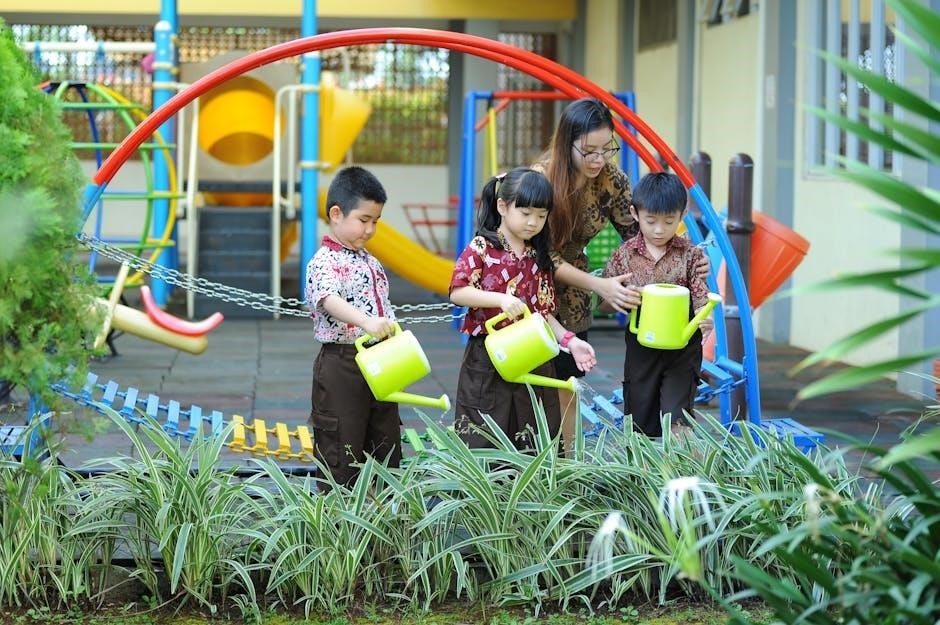
Community-Based Instruction (CBI) is an educational approach connecting learning to real-world experiences through community partnerships, fostering practical skill development and social awareness among students.
1.1 Overview of Community-Based Instruction
Community-Based Instruction (CBI) is an educational strategy that emphasizes learning through real-world experiences in community settings. It connects academic concepts to practical applications, fostering skills like problem-solving and collaboration. By engaging students in authentic environments, CBI promotes meaningful learning and prepares them for future challenges. This approach encourages partnerships between schools and communities, creating a bridge between education and real-life applications.
1.2 Historical Development of CBI
Community-Based Instruction (CBI) emerged in the 1960s and 1970s as part of progressive education reforms. It drew from experiential learning theories and the belief that real-world experiences enhance education. By the 1980s and 1990s, CBI gained structure, emphasizing collaborative learning and community engagement. The approach has since evolved, integrating technology and diverse perspectives to meet modern educational needs and societal challenges.
Defining Community-Based Instruction
Community-Based Instruction (CBI) is an educational strategy integrating learning with community involvement, emphasizing practical experiences and collaboration to enhance student understanding and skill development.
2.1 Key Characteristics of CBI
Community-Based Instruction (CBI) emphasizes experiential learning, fostering collaboration between schools and communities. It focuses on real-world applications, skill development, and cultural sensitivity, ensuring student-centered, inclusive, and meaningful educational experiences.
2.2 Theoretical Foundations of CBI
Community-Based Instruction is rooted in experiential learning theory, emphasizing hands-on experiences and real-world applications. It aligns with social constructivism, fostering learning through collaboration and community engagement. The approach also draws from place-based education, integrating local contexts to enhance relevance and meaning, ensuring students develop practical skills and a deeper connection to their communities.

Benefits of Community-Based Instruction
Community-Based Instruction bridges education and community, preparing students for real-world challenges while fostering partnerships and social responsibility, enhancing practical skills and community engagement effectively.
3.1 Educational Benefits for Students
Community-Based Instruction offers students authentic learning experiences, connecting academic concepts to real-world applications. It enhances critical thinking, problem-solving, and collaboration skills while fostering a deeper understanding of diverse perspectives. Students gain practical knowledge, emotional intelligence, and a sense of responsibility, preparing them to navigate complex societal challenges effectively. This approach also boosts engagement and motivation, making learning more meaningful and impactful.
3.2 Societal Benefits and Community Engagement
Community-Based Instruction strengthens societal bonds by fostering partnerships between schools and local organizations. It promotes collective responsibility for education, enriching community resources and addressing societal needs. Students’ involvement in real-world issues encourages active citizenship and empathy, while communities benefit from young minds contributing fresh perspectives. This collaboration creates a supportive environment for both students and society to thrive together.
Implementing Community-Based Instruction
Effective CBI implementation involves collaboration between educators and community members, developing strategies that align with community needs and fostering engagement through hands-on, real-world learning experiences for students.
4.1 Strategies for Effective Implementation
Effective implementation of CBI requires strategic planning, collaboration between educators and community members, and alignment of learning objectives with real-world applications. Educators should identify community partners, integrate relevant resources, and ensure activities are inclusive and culturally sensitive. Technology tools, such as digital platforms, can enhance engagement and accessibility. Continuous feedback mechanisms and professional development for educators further support successful program execution and sustainability.
4.2 Role of Educators and Community Members
Educators play a crucial role in designing curriculum and coordinating community activities, while community members provide resources and expertise. Collaboration between these groups ensures authentic learning experiences. Educators facilitate engagement, and community partners offer real-world insights, fostering mutual benefits. This partnership strengthens educational outcomes and promotes societal involvement in student development.
Challenges in Community-Based Instruction
Challenges include resource limitations, coordination between schools and communities, and inconsistent participation. Addressing these requires innovative strategies and strong collaboration to ensure program success and sustainability.
5.1 Common Challenges Faced
Challenges in CBI include limited resources, coordination difficulties between schools and communities, and inconsistent participation. Educators may lack training in integrating community-based learning, and managing diverse student needs can be complex. These challenges highlight the need for strategic planning and robust support systems to ensure successful implementation and achieve meaningful student outcomes effectively.
5.2 Addressing Challenges Through Innovation
Innovative strategies like leveraging technology, fostering community partnerships, and adopting flexible learning models can mitigate CBI challenges. Educators can utilize digital tools to enhance engagement and accessibility. Collaborative planning and professional development for teachers also play a crucial role in overcoming obstacles. Innovative approaches ensure that CBI remains effective and adaptable, ultimately enriching the learning experience for students and communities alike.

The Role of Technology in CBI
Technology enhances CBI by providing digital tools, online platforms, and resources that facilitate interactive learning and community engagement, connecting educational activities with real-world applications effectively.
6.1 Technology Tools for Enhancing CBI
Technology tools like online learning platforms, mobile apps, and collaboration software enhance CBI by providing interactive learning experiences and fostering community engagement. These tools enable students to connect with real-world applications, access resources, and participate in projects remotely. AI-powered chatbots and virtual simulations further enrich learning, offering personalized support and immersive experiences that align with community-based objectives, making education more accessible and effective.
6.2 Leveraging Digital Platforms for Engagement
Digital platforms, such as online learning hubs and social media, enhance community-based instruction by fostering interaction between students, educators, and community members. These tools enable virtual field trips, collaborative projects, and real-time feedback, making learning more dynamic and inclusive. They also provide accessible resources, promoting engagement and bridging gaps between classroom and community, ensuring diverse participation and enriched learning experiences for all students.

Community Partnerships in CBI
Community partnerships in CBI foster collaboration between schools and local organizations, creating opportunities for shared goals and mutual benefits, enhancing student learning and community engagement.
7.1 Building Effective Partnerships
Building effective partnerships requires clear communication, shared goals, and mutual respect. Schools and communities must identify common objectives, establish trust, and define roles. Regular collaboration and feedback ensure alignment and sustainability. Strong partnerships often involve dedicated coordinators, professional development, and open dialogue to address challenges and celebrate successes, fostering a supportive environment for student and community growth.
7.2 Successful Partnership Case Studies
A high school partnered with local businesses to provide vocational training, enhancing students’ employability. Another district collaborated with NGOs to integrate community service into curriculum, fostering civic responsibility. These partnerships highlight the importance of alignment with educational goals and community needs, resulting in measurable student outcomes and stronger community ties through collaborative efforts and shared resources.
Cultural Sensitivity in CBI
Cultural sensitivity is crucial in CBI, ensuring inclusive learning environments that respect diverse backgrounds, fostering mutual respect, and promoting equitable opportunities for all participants.
8.1 Importance of Cultural Sensitivity
Cultural sensitivity is vital in CBI as it ensures respectful and inclusive learning environments, fostering understanding of diverse backgrounds and perspectives. This approach promotes equity and empathy, allowing students and community members to collaborate effectively. By valuing cultural differences, CBI programs create meaningful connections, enhance social cohesion, and prepare students to navigate a globalized world with respect and awareness.
8.2 Integrating Diverse Perspectives
Integrating diverse perspectives enriches learning by incorporating varied cultural, social, and experiential viewpoints. This approach fosters collaboration between students and community members, promoting mutual understanding and respect. By valuing diverse voices, CBI creates inclusive environments that reflect real-world dynamics, preparing students to engage effectively in global and multicultural settings while fostering empathy and social cohesion.

Assessment and Evaluation in CBI
Assessment and evaluation in CBI involve measuring student learning through observations, portfolios, and community feedback, ensuring alignment with real-world goals and skill development.
9.1 Methods for Assessing Student Learning
Assessment in CBI involves diverse methods like portfolios, performance tasks, and community feedback to evaluate real-world application of skills. Technology tools and self-paced systems also track progress, ensuring alignment with learning objectives and fostering accountability. These approaches provide comprehensive insights into student growth and practical skill development in community-based settings.
9.2 Evaluating Program Effectiveness
Evaluating CBI programs involves analyzing real-world outcomes, student performance, and community impact. Tools like portfolios, teacher feedback, and technology platforms track progress. Data from self-paced systems and chatbot interactions provide insights into skill mastery and engagement. Continuous assessment ensures programs adapt to needs, fostering improved learning experiences and stronger community connections.
Real-World Applications and Case Studies
Community-Based Instruction is applied in classrooms and partnerships, enhancing skill development through real-world learning. Successful global programs demonstrate improved engagement and practical skill mastery among students.
10.1 Successful CBI Programs Globally
Community-Based Instruction has been successfully implemented worldwide, with programs in countries like the U.S., Canada, and Australia. These initiatives often involve partnerships with local organizations, fostering real-world learning experiences. For instance, a middle school in the U.S. integrated CBI into its curriculum, resulting in improved academic performance and increased community engagement. Such programs highlight the effectiveness of CBI in diverse educational settings, promoting practical skill development and social responsibility.
10.2 Lessons Learned from Implementations
Implementing CBI highlights the importance of strong community-educator collaboration and cultural sensitivity. Effective communication and shared goals ensure successful outcomes. Programs often reveal the need for flexibility and adaptability to meet diverse student needs. Technology integration can enhance engagement but requires proper training. Continuous feedback loops and evaluation mechanisms are crucial for improvement. These insights underscore the value of iterative refinement in CBI programs.
Future Trends in Community-Based Instruction
Future trends in CBI emphasize integrating advanced technologies, fostering global collaborations, and prioritizing equity and inclusivity to create adaptive, learner-centered experiences that align with societal needs.
11.1 Emerging Trends and Innovations
Emerging trends in CBI include the integration of advanced technologies like AI, VR, and gamification to enhance real-world learning experiences. Personalized learning pathways and data-driven assessments are becoming central, enabling tailored instruction. Innovations in digital platforms foster global collaborations, while community-driven projects emphasize sustainability and equity. These trends aim to create immersive, inclusive, and adaptive learning environments that prepare students for future challenges.
11.2 Preparing for Future Challenges
To address future challenges, CBI must emphasize adaptability, innovation, and collaboration. Educators should invest in professional development to integrate new technologies and address diverse student needs. Strengthening community partnerships and fostering student resilience will be critical. By prioritizing equity and sustainability, CBI can evolve to meet global demands, ensuring learners are prepared for an ever-changing world.
Community-Based Instruction empowers students through real-world learning experiences, fostering essential skills and community ties. Its impact extends beyond education, creating socially aware, engaged, and resilient individuals for the future.
12.1 Summary of Key Points
Community-Based Instruction (CBI) connects academic learning with real-world experiences, fostering practical skills, social awareness, and community engagement. It emphasizes partnerships, cultural sensitivity, and technology integration while addressing challenges through innovation. CBI benefits students educationally and socially, while enriching communities, making it a transformative approach for modern education.
- Focuses on real-world application of learning.
- Encourages community involvement and partnerships.
- Addresses diverse student needs and cultural contexts.
- Leverages technology for enhanced engagement.
- Requires collaboration between educators and community members.
12.2 Final Thoughts on CBI’s Impact
Community-Based Instruction (CBI) offers transformative potential for education by bridging academic and real-world learning. It fosters empowerment, equity, and societal engagement, preparing students for future challenges while enriching communities. By prioritizing collaboration and cultural sensitivity, CBI creates holistic learning environments that inspire lifelong growth and meaningful contributions to society.
- Empowers students through real-world application.
- Strengthens community ties and social responsibility.
- Prepares learners for diverse future challenges.